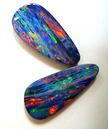LA-ICP-MS: (Laser
ablation-inductively coupled plasma-mass spectrometry): a
new way to determine origin and detect treatments of
gemstones.
LA-ICP-MS
is an analytical technique used to detect the chemical
composition of gems. It reveals both additives from
gemstone treatments and trace elements that can help
determine a gemstone’s probable geographic origin. And
that’s a good thing.
One of the most troublesome
developments in gemstone enhancement in recent years has
been the large-scale beryllium diffusion treatment of
natural sapphire. This treatment can result in color
enhancement including complete color change in some cases.
(“Rainbow sapphires” are produced by this treatment.)
Unlike previous diffusion
treatments, beryllium diffusion penetrates the entire stone
and is impossible to detect without sophisticated testing.
Originally only the yellow-orange-purple-pink part of the
spectrum was thought to be affected, but we now know that
in all probability, nearly all sapphire undergoes this
treatment, including classic blue sapphire.
In LA-ICP-MS testing, a
minute amount of the gem sample is vaporized by a
high-energy laser beam, and the vaporized material is
ionized into a plasma by a high-frequency power generator.
Even trace elements in the parts per billion range can be
identified. The test leaves a tiny spot on the surface of
the sample, and cut gems are generally tested on the bottom
of the stone in an area that can easily be repolished.
LA-ICP-MS allows gemologists
to definitively diagnose beryllium diffusion and other
treatments. It also makes possible the cataloging of the
precise makeup of gems from specific sources, which may
ultimately solve the dilemma of place-name designations.
This month's sources include "Chemical
Fingerprinting by LA-ICP-MS” by Abduriyim,
Kitawaki, Furuya and Schwarz (Gems and Gemology volume
XLII).

Members of the following:
American Gem Trade Association (AGTA)
American Craft Council
WI Jewelers Association
Jewelers of America
Australian Opal Association
